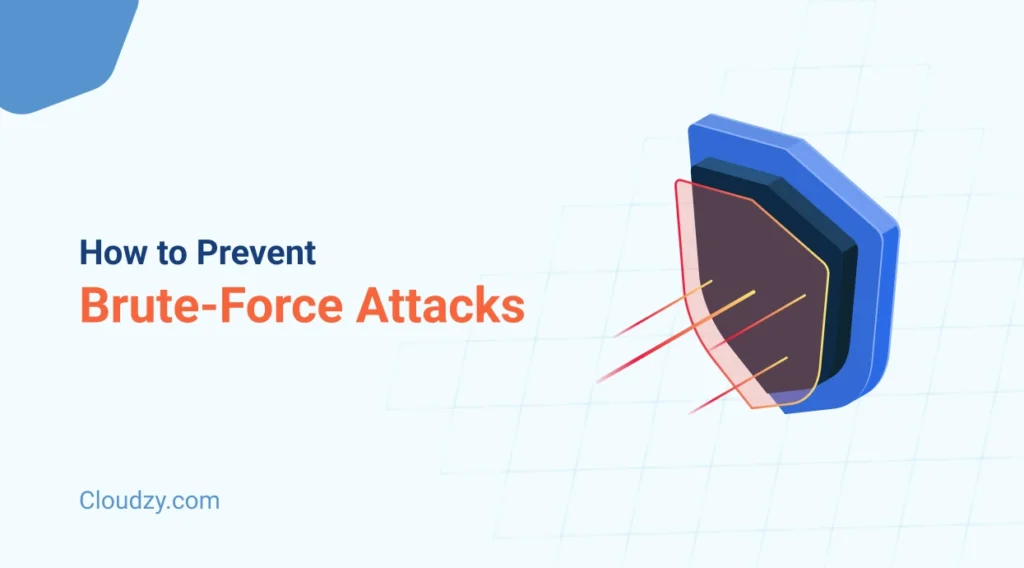Brute force attacks are one of the oldest tricks in the hacker’s playbook, yet they remain incredibly effective. Picture someone tirelessly trying to guess the combination to your safe except instead of just one person, it’s a powerful algorithm testing millions of combinations every second.
In this article, I’ll get into the nitty-gritty of the mechanics of brute-force attacks, their different types, and, most importantly, how to prevent brute-force attacks effectively. We’ll cover essential strategies, platform-specific defenses, and advanced tools to help you secure your systems and outsmart cybercriminals.
What is a Brute-Force Attack?
One of the most common attacks a web developer can face is a brute-force attack. This is where attackers use algorithms that try each combination of letters, numbers, and symbols in a trial-and-error method until they find the right combination.
What’s difficult about this kind of attack is its simplicity and sheer persistence; there’s no clever trick or special loophole that can be easily discovered and blocked off, as passwords are a crucial part of any security system.
Brute force attacks aren’t picky—they target whatever they can get their hands on, from personal accounts to major corporate systems. But, the impact of these attacks often depends on the platform in question. A compromised WordPress admin login could mean defaced websites or stolen customer data, while an SSH brute force attack might open the floodgates to a company’s entire server infrastructure.
These attacks also take a toll on reputation and cause costly downtimes. Businesses that rely on online operations, like eCommerce or SaaS providers, often lose both revenue and customer trust during breaches. 60% of small businesses close within six months of a major cyberattack, which shows you just how devastating these incidents can be.
But before we talk about how to prevent brute-force attacks, you need to know how they work, and the different types of brute-force methods attackers use.
 Start Blogging
Start Blogging
Self-host your WordPress on top-tier hardware, featuring NVMe storage and minimal latency around the world — choose your favorite distro.
Get WordPress VPS
Different Types of Brute-Force Attacks
There are several flavors of brute-force attacks.
- Dictionary Attacks: Target easily guessable passwords by repeatedly trying a list of commonly used passwords, such as “123456” or “password.”
- Credential Stuffing: Hackers use leaked username-password combinations from past breaches to gain access to multiple accounts.
- Reverse Brute-Force Attacks: Involve starting with a known password (such as “123456” or “welcome”) and systematically checking it against countless usernames to find a match, similar to fishing with one bait.
- Rainbow Table Attacks: Utilize precomputed tables that map hashes to passwords, allowing faster cracking of hashed passwords without computing each hash on the spot.
- Password Spraying: Instead of bombarding a single account with multiple password guesses, a few common passwords are tested across many usernames to exploit weaknesses without triggering lockouts.
- Online Brute-Force Attacks: Target live systems like websites and apps. They interact with servers but may face potential throttling or rate limiting, making them slower yet dangerous against weak login forms.
- Offline Brute-Force Attacks: Conducted on a stolen file of encrypted passwords, allowing hackers to test decryption keys at high speed on their machines, undetected by firewalls or monitoring systems.
Why are these attacks so prevalent? A big part of the problem is us. Studies show that 65% of people reuse passwords across multiple accounts. It’s like giving a thief a master key—once they have one password, they can potentially unlock everything. And it doesn’t help that passwords like “qwerty” are still topping the charts as favorites year after year.
To put into the picture how common these attacks are, here’s a statistic: 22.6% of all login attempts on eCommerce websites in 2022 were brute force or credential-stuffing attacks. That’s nearly one in four attempts! Businesses faced fraudulent purchases, customer data theft, and major PR nightmares because of these relentless attacks.
Moreover, hackers scope out target site pages and fine-tune their brute force tools to match the site’s specific parameter requirements. Login pages are the obvious targets, but CMS admin portals are also popular hotspots for attackers. These include:
- WordPress: Common entry points like wp-admin and wp-login.php.
- Magento: Vulnerable paths such as /index.php and admin panels.
- Joomla!: Its administrator page is a frequent bullseye.
- vBulletin: Admin dashboards like admin cp often find themselves in the crosshairs.
The good news? Understanding the risks is half the battle. Whether you’re securing a WordPress site, an SSH server, or any other platform, knowing where your vulnerabilities lie is the first step in how to prevent brute-force attacks in the first place.
Best Practices for How to Prevent Brute-Force Attacks
Stopping brute force attacks requires a mix of common sense and smart strategies. Think of it as locking every door and window in your house—and adding a security system just in case. These best practices work across most platforms and give you a strong foundation for keeping your systems safe and are important steps in how to prevent brute-force attacks.
Use Strong, Unique Passwords
Weak or reused passwords are an open invitation for brute force attacks. Choose passwords that are at least 12 characters long, include a mix of letters, numbers, and symbols, and avoid anything predictable. A study found that “123456” and “password” were still among the most common passwords in 2022.
Implement Multi-Factor Authentication (MFA)
With MFA, even if a hacker guesses your password, they’ll need an additional verification step, like a one-time code sent to your phone. According to Microsoft, MFA blocks more than 99.2% of account compromise attacks. Check out our guide on how to enable Two-Factor Authentication on Windows 10.
Enable Account Lockouts
Limit failed login attempts before temporarily locking the account. This simple feature stops brute force attacks in their tracks.
Set Up Rate Limiting
Restrict how often login attempts can be made within a timeframe. For example, allowing only five attempts per minute can make brute-force attacks less likely.
Monitor and Respond to Unusual Activity
Use tools like intrusion detection systems (IDS) to catch brute force attempts early.
The best defense is layered. Combining these tactics and knowing how to stop brute force attacks makes it much harder for attackers to succeed. Next, we’ll explore how to apply these principles to specific platforms like WordPress, where brute-force attacks are especially common.
Brute-Force Attack Prevention on WordPress
WordPress sites are hacker magnets. With millions of websites running on the platform, attackers know the odds are in their favor of finding one with weak security. Knowing how to prevent brute force attacks on WordPress can make all the difference—and it’s easier than you think.
Change the Default Login URL
Hackers target the default login page (/wp-admin or /wp-login.php). Switching to a custom URL is like moving the front door—much harder for attackers to find.
Install Security Plugins
Plugins like Wordfence and Sucuri offer powerful brute force attack prevention tools, including CAPTCHAs, IP blocking, and real-time monitoring.
Disable XML-RPC
XML-RPC is a gateway hackers exploit for login attempts. Disabling it is a must for reducing vulnerability to brute force attacks WordPress sites commonly face.
Add CAPTCHA to Login Pages
CAPTCHA ensures only humans can log in, shutting down automated brute force tools.
Harden wp-config.php
Restrict access to wp-config.php, your site’s blueprint, by adjusting .htaccess or server rules.
Update Regularly
Outdated plugins and themes are open doors for attackers. Regular updates patch known vulnerabilities, protecting against brute force attack WordPress risks. This is key to defending against a brute force attack WordPress sites are so prone to.
With these steps, your WordPress site becomes significantly more secure. Next, we’ll tackle securing SSH servers, another frequent target for brute force attacks.
Securing Against SSH Brute-Forcing
SSH servers are like the digital keys to your kingdom, which makes them prime targets for hackers. Knowing how to prevent brute force attacks on SSH isn’t just smart—it’s critical for protecting sensitive systems.

Use SSH Key Authentication
Password-based logins are risky. Switching to SSH key authentication adds an extra layer of security, as attackers need access to your private key, not just a guessed password. This drastically reduces the success rate of SSH brute force attacks.
Disable Root Login
The root user is often the first target in SSH brute forcing. Disable direct root login and create a separate user account with limited privileges. Hackers can’t brute force what they can’t target.
Set Up UFW and Fail2Ban
Tools like UFW and Fail2Ban monitor failed login attempts and block IPs showing suspicious behavior. It’s one of the most effective defenses for how to stop brute-force attacks on SSH servers. Here’s our detailed guide on how to install, enable, and manage UFW and Fail2Ban.
Change the Default Port
By default, SSH uses port 22, and hackers know it. Moving SSH to a non-standard port adds a simple but effective layer of obscurity.
Use IP Whitelisting
Restrict SSH access to specific IP addresses. This blocks unwanted traffic entirely, preventing brute force tools from even getting started.
With these steps, your SSH server will be far less vulnerable to attacks. Now that we’ve covered common practices in how to prevent brute-force attacks let’s talk about combatting specific tools these attackers use.
Commonly Used Brute-Force Attack Tools and How to Combat Them
While the above practices can significantly help with brute-force attack prevention, they’re mostly general stuff for how to prevent brute-force attacks; however, the thing is that many attackers use a few certain tools, and knowing how to combat them is very important.
Wi-Fi Password Cracking Tools
Aircrack-ng: A versatile tool for cracking Wi-Fi passwords through dictionary attacks on WEP, WPA, and WPA2-PSK, available for multiple platforms.
- Mitigation: Use WPA3 encryption, create long and complex passwords, enable MAC address filtering, and deploy wireless intrusion detection systems (WIDS).
General Password Cracking Tools
John the Ripper: Identifies weak passwords and cracks them using brute force or dictionary attacks, supporting 15+ platforms, including Windows and Unix.
- Mitigation: Enforce strong password policies (minimum 12 characters, high complexity), use salted hashes, and perform regular password audits and rotation.
Rainbow Crack: Utilizes precomputed rainbow tables to speed up password cracking, supporting both Windows and Linux.
- Mitigation: Use salted hashes to render rainbow tables ineffective and apply hashing algorithms like bcrypt, Argon2, or script.
L0phtCrack: Cracks Windows passwords using dictionary, brute-force, hybrid attacks, and rainbow tables while supporting advanced features like hash extraction and network monitoring.
- Mitigation: Lock accounts after failed attempts, use passphrases for stronger entropy, and enforce multifactor authentication (MFA).
Ophcrack: Focuses on cracking Windows passwords through LM hashes using built-in rainbow tables, often completing in minutes.
- Mitigation: Upgrade to systems that don’t rely on LM hashes (e.g., Windows 10+), use long, complex passwords, and disable SMBv1.
Advanced and Multi-Purpose Password Tools
Hashcat: A GPU-accelerated tool that supports a variety of hashes and attacks like brute force, dictionary, and hybrid.
- Mitigation: Enforce strong password policies, securely store hash files, and encrypt sensitive data with strong keys.
DaveGrohl: Mac OS X-exclusive tool supporting distributed brute force and dictionary attacks.
- Mitigation: Audit Mac OS X systems, restrict password file access, and enforce multifactor authentication (MFA).
Network Authentication and Protocol Tools
Ncrack: Cracks network authentication protocols like RDP, SSH, and FTP across various platforms.
- Mitigation: Restrict access to network-facing services via firewalls, enforce IP-based blocking after multiple failed login attempts, and use non-default ports for critical services.
THC Hydra: Performs dictionary-based brute force attacks on over 30 protocols, including Telnet, FTP, and HTTP(S).
- Mitigation: Enforce CAPTCHA or other mechanisms to limit retries, utilize encrypted protocols (e.g., FTPS, HTTPS), and require MFA for secure access
Specialized Tools for Web, Subdomains, and CMS
Gobuster: Ideal for brute-forcing subdomains and directories in web penetration testing.
- Mitigation: Use web application firewalls (WAFs), restrict access to sensitive directories, and hide or obfuscate default file structures.
Research: Discovers hidden web paths and directories during security testing.
- Mitigation: Use .htaccess or server rules to restrict access, remove unused directories, and secure sensitive web paths
Burp Suite: A complete web security testing suite with brute force and vulnerability scanning capabilities.
- Mitigation: Regularly patch web applications, conduct penetration testing, and monitor for anomalous brute force activity.
CMSeek: Focuses on discovering and exploiting CMS vulnerabilities during testing.
- Mitigation: Keep CMS platforms updated, secure configurations, and limit brute-force attempts with protective plugins.
Token, Social Media, and Miscellaneous Tools
JWT Cracker: Specializes in cracking JSON Web Tokens for testing purposes.
- Mitigation: Use long, secure keys for JWT signing, enforce short token expiration times, and reject weak or unsigned algorithms.
SocialBox: Used for social media account brute-force testing.
- Mitigation: Enable account lockout after failed attempts, enforce two-factor authentication, and educate users on phishing awareness.
Predictor: A dictionary builder for creating customized wordlists for brute-force attacks.
- Mitigation: Monitor for credential leaks, avoid using weak default passwords, and enforce continuous audits for security.
Patator: A multi-purpose brute force tool supporting diverse protocols and methods.
- Mitigation: Implement rate limiting, custom error messages, and strong account lockout mechanisms to slow attackers.
Nettracker: Automates penetration testing tasks, including brute force and other assessments.
- Mitigation: Regularly monitor network logs, isolate test credentials, and ensure penetration tools are securely managed.
Final Thoughts and Advanced Brute-Force Attack Prevention Measures
Advanced tools like behavioral analysis software, honeypots, and IP reputation blockers can spot and stop threats before they take hold. These proactive measures work alongside the main ones, like multi-factor authentication and strong passwords, to create a rock-solid defense.
Learning how to prevent brute force attacks means thinking long-term. Pairing smart strategies with brute force attack prevention tools helps protect your systems from even the most persistent attackers. Stay sharp, stay adaptable, and treat cybersecurity as an investment in your future.

8 thoughts on “How to Prevent Brute Force Attacks: Best Brute-Force Attack Prevention Strategies for WordPress and SSH”
Do you have any idea How fast is a brute force attack?
Modern PCs will brute force crack an eight character alphanumerical word – capitals and lowercase letters, numbers, and special characters in concerning 60 minutes.
I do trust all the ideas you have presented on your post.
Can a Brute Force Attack compromise a Facebook password?
Yes, It is possible for simple passwords but Thanks to Multi-Factor Authentication (MFA) can help prevent some of the most common and successful types of cyberattacks,
With brute force, how do we know if we found the key?
Brute force attackers guess passwords, passphrases, and personal keys in a shot to eventually get the proper answer and crack the safety of a system. They consistently guess each combination
Блекфрайдей так повелось жить неотложно следом
Четверга благодарения, каковой подмечают в последний
четвертый день недели ноября.
В данном годку Black Friday припадает
получи и распишись 26 ноября 2021 года.
Во почти всех торговых заведениях пристало приступать распродажу утром в пятницу (а сеть-магазины – с северы) и возобновлять в микротечение последующих
двух выходных дней.
I appreciate the detailed explanation of brute-force attacks and the various prevention strategies. The multi-factor authentication tip was especially useful!